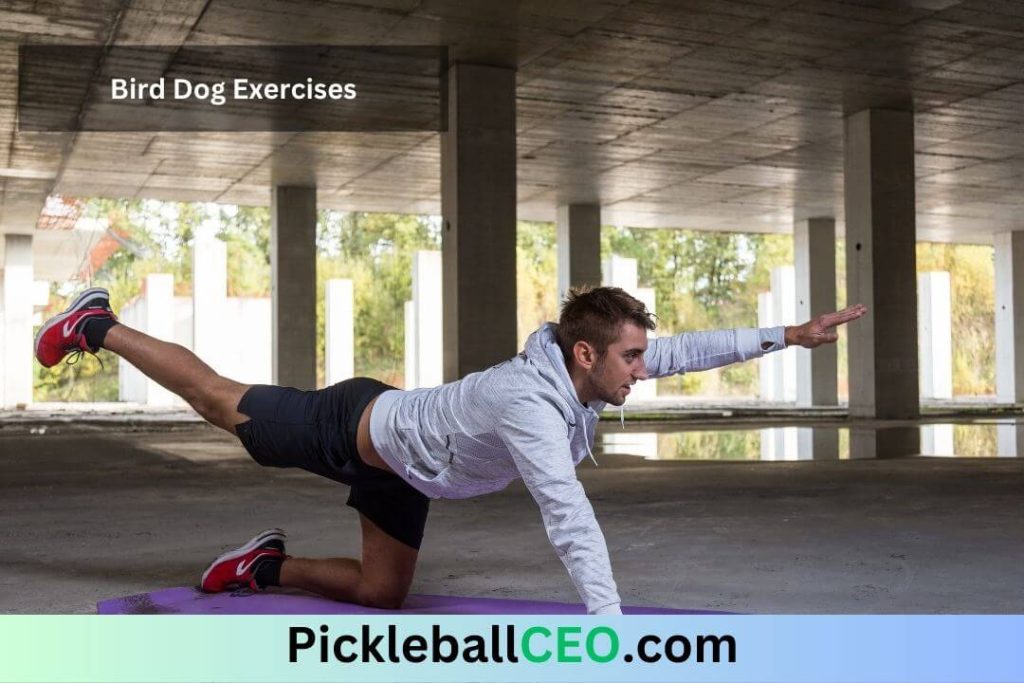Introduction And Exercises to Keep Your Back Healthy
Pickleball is an exciting and fast-paced sport that requires agility, quick movements, and strong core muscles, including the muscles in your back. To perform at your best and prevent back injuries, it’s essential to incorporate exercises that target and strengthen your back muscles. In this article, we will discuss five effective exercises that will help keep your back healthy and enhance your performance in pickleball.
1. Bird Dog


The Bird Dog exercise is an excellent way to engage your back muscles and improve core stability. Here’s how to do it:
Starting Position
Begin on all fours with your hands directly under your shoulders and your knees under your hips. Ensure that your body is in a neutral position, with your spine straight and your head aligned with your spine.
Arm and Leg Extension
Engage your core by drawing your navel towards your spine. While maintaining a stable core, extend your right arm forward, reaching it out in front of you. At the same time, extend your left leg backward, ensuring that it remains in line with your hips and doesn’t lift too high or sag down.
Maintain Proper Alignment
As you extend your arm and leg, focus on keeping your hips and shoulders parallel to the ground. Avoid arching or rounding your back, as this may compromise the effectiveness of the exercise and put unnecessary strain on your spine. Maintain a strong and stable core throughout the movement.
Hold and Return
Hold the extended position for a few seconds, allowing your muscles to engage and activate. Feel the contraction in your back muscles as you balance on three points of contact (both hands and the opposite knee). Then, gently return to the starting position by bringing your arm and leg back to the ground.
Repeat on the Opposite Side
After completing the repetitions on one side, switch to the other side. Extend your left arm forward and your right leg backward, following the same instructions as before. Alternate between sides for a set of 10 repetitions on each side, or adjust the number of repetitions according to your fitness level and comfort.
Incorporating the Bird Dog exercise into your workout routine can help strengthen your back muscles, improve core stability, and enhance your performance in pickleball. Focus on maintaining proper form and engaging the targeted muscles throughout the exercise. Remember to breathe steadily and listen to your body, stopping the exercise if you experience any pain or discomfort.
2. Superman
The Superman exercise targets the muscles in your lower back and helps improve overall back strength. Here’s how to perform it:
Starting Position
Lie face down on a mat or the floor with your legs extended and your arms stretched out in front of you. Ensure that your palms are facing down, and your head is in a neutral position.
Lift Arms, Chest, and Legs
Engage your lower back muscles by squeezing your glutes and lifting your arms, chest, and legs off the ground simultaneously. Keep your gaze down to maintain proper alignment and avoid straining your neck.
Hold the Superman Position
Hold the lifted position for a few seconds, focusing on contracting your lower back muscles. Keep your limbs and torso extended, aiming to create a straight line from your fingertips to your toes. Remember to breathe steadily throughout the exercise.
Lower to the Starting Position
Gently lower your arms, chest, and legs back to the starting position, maintaining control and avoiding any sudden movements. Rest briefly before starting the next repetition.
Repeat for a Set
Repeat the exercise for a set of 10 repetitions, or adjust the number of repetitions based on your fitness level and comfort. Focus on maintaining proper form and controlled movements throughout the exercise, emphasizing the engagement of your lower back muscles.
By incorporating the Superman exercise into your workout routine, you can strengthen your lower back muscles and improve overall back strength. Remember to start with a comfortable range of motion and gradually increase intensity as your back muscles become stronger. If you experience any pain or discomfort, modify the exercise or consult with a healthcare professional for guidance.
3. Plank


The Plank exercise is a fantastic way to strengthen your entire core, including your back muscles. Follow these steps to perform a standard plank:
Starting Position
Begin by lying face down on the ground. Position your forearms on the ground, ensuring that your elbows are directly under your shoulders. Align your body in a straight line from head to toe.
Lift Your Body
Engage your core and lift your body off the ground, supporting your weight on your forearms and toes. Keep your elbows at a 90-degree angle and your forearms parallel to each other. Your body should form a straight line from your head to your heels.
Engage Your Core and Back Muscles
Focus on engaging your core and back muscles throughout the exercise. Avoid sagging or arching your lower back. Imagine pulling your belly button toward your spine to maintain proper alignment.
Hold the Plank Position
Hold the plank position for 30 seconds to a minute, or as long as you can maintain proper form and engage your muscles effectively. Keep your breathing steady and avoid holding your breath.
Increase Duration Gradually
As you become more comfortable with the exercise, gradually increase the duration of the plank. Aim to challenge yourself without compromising your form. Start by adding a few seconds each time you perform the exercise until you can hold the plank for an extended period.
The plank is an excellent exercise to strengthen your core, including your back muscles. It helps improve stability, posture, and overall body control. Remember to focus on proper form and engage your muscles throughout the exercise for maximum benefit.
4. Reverse Snow Angels
Reverse Snow Angels target the muscles in your upper back and shoulders, promoting better posture and stability. Here’s how to perform this exercise:
Starting Position
Lie face down on the ground with your arms extended by your sides and palms facing the floor. Keep your legs extended and your toes touching the ground.
Squeeze Shoulder Blades and Lift Arms
Squeeze your shoulder blades together and lift your arms off the ground. Keep your arms straight and parallel to the floor, maintaining a slight bend in your elbows. Your palms should face down throughout the exercise.
Form a “Y” Shape
While keeping your arms straight, bring them up and overhead, forming a “Y” shape with your body. Focus on using your upper back muscles to initiate the movement and maintain control throughout.
Slowly Lower Arms
Slowly lower your arms back to the starting position, maintaining control and engaging your back muscles. Avoid dropping your arms too quickly or losing tension in your muscles.
Repeat for a Set
Repeat the exercise for a set of 10 repetitions, focusing on smooth and controlled movements. Squeeze your shoulder blades together at the top of the movement to maximize muscle engagement.
Performing Reverse Snow Angels regularly can help strengthen your upper back and shoulder muscles, improve posture, and enhance stability. Remember to maintain proper form, breathe steadily, and listen to your body. Adjust the intensity and range of motion based on your comfort and fitness level.
5. Cat-Cow Stretch
The Cat-Cow Stretch is a gentle exercise that helps improve flexibility and mobility in your spine. Follow these steps to perform it:
Starting Position
Begin on all fours with your hands directly under your shoulders and your knees under your hips. Keep your wrists aligned with your shoulders and your knees aligned with your hips. Maintain a neutral spine position with your head in line with your spine.
Cat Position
Start by arching your back upward, bringing your chin toward your chest, and rounding your spine like a scared cat. Draw your navel toward your spine and focus on stretching your upper back while relaxing your neck and shoulders. Hold this position for a few seconds.
Cow Position
Transition into the Cow position by dropping your belly toward the floor, lifting your head and tailbone, and extending your spine. Arch your back in the opposite direction, allowing your belly to sink toward the ground. Lift your gaze upward and open your chest. Hold this position for a few seconds.
Flow Between Cat and Cow
Repeat this flow, moving between the Cat and Cow positions, for a set of 10 repetitions. Coordinate your movements with your breath, inhaling as you transition into the Cow position and exhaling as you transition into the Cat position. Focus on maintaining fluid and controlled movements, allowing your spine to gently flex and extend.
The Cat-Cow Stretch helps to mobilize and stretch your spine, promoting flexibility and relieving tension in your back. It also helps to improve posture and can be beneficial for those experiencing back stiffness or discomfort. Take your time with each movement, and listen to your body. Modify the range of motion if needed and avoid any positions that cause pain.
Conclusion
Incorporating these five exercises into your fitness routine will help keep your back healthy and strong for pickleball. By targeting different muscle groups in your back and core, these exercises promote stability, flexibility, and overall back health. Remember to start with proper form and gradually increase the intensity as your muscles become stronger. Listen to your body and make adjustments as needed. By prioritizing back strength and flexibility, you can enhance your performance on the pickleball court and reduce the risk of injuries. Keep practicing these exercises consistently to enjoy a pain-free and successful pickleball journey.






